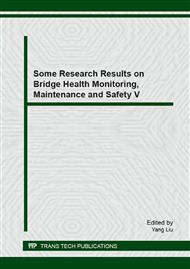p.9
p.17
p.25
p.35
p.45
p.53
p.61
p.72
p.80
Static Model Experiment Study on a Concrete-Filled Steel Tubular Arch Bridge
Abstract:
It is well known that a lot of concrete filled steel tubular (CFST) arch bridges were built in China. Thus it became a main bridge type. Its architectural design shows much novelty, while the structural design is always conducted based on the finite element (FE) model analysis. Meanwhile there is no professional code for design and construction of this type of bridge. To overcome these disadvantages, scaled model tests are preferable to evaluate the mechanical behavior and provide guidelines for design and construction of prototype bridges. In this paper, an irregular CFST arch bridge as the prototype was introduced and a 1/16 scaled bridge model was designed and constructed according to the similarity theory. The experimental study on the scaled model was aimed to simulate the construction stages and mechanical behavior under moving loads. The test results are used to make comparison with the construction monitoring and bearing-capacity load test of the prototype. The analysis shows that the experimental results of the scaled model are close to the measured results of the prototype. The scaled model test was proved to be valuable for the pre-camber setup of the arch rib and the tension optimization of the suspenders and for the operation safety.
Info:
Periodical:
Pages:
61-71
Citation:
Online since:
June 2015
Authors:
Price:
Сopyright:
© 2015 Trans Tech Publications Ltd. All Rights Reserved
Share:
Citation:


